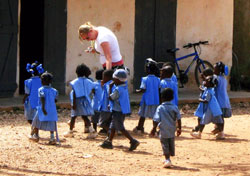Religious Education Supplement
A passion for service: Young adults discover that acts of service enrich and deepen their lives of faith

Erica Heinekamp, a member of St. John the Evangelist Parish in Indianapolis, leads children back to their classroom at a parish school in Haiti after they came outside to see her. The fourth-grade teacher at St. Susanna School in Plainfield has taken two mission trips to Haiti that have enriched her faith. (Submitted photo)
By Sean Gallagher
Four years ago, Jonathan Higgins was not motivated by high ideals when he signed up for Homeland Mission, an annual week of service for archdiocesan teenagers.
The member of Our Lady of Lourdes Parish in Indianapolis simply saw it as a quick chance to fulfill the service hours requirement in his parish’s confirmation preparation program.
A lot can change in four years, though.
When Higgins graduated from Father Thomas Scecina Memorial High School in Indianapolis, he received its John Henninger Christian Service Award that honors one senior for his or her service in the school and the broader community.
And today, Higgins is a freshman at the University of Dayton in Dayton, Ohio pursuing training for a career dedicated to service as a music therapist.
“Originally, I was thinking a lot about engineering,” Higgins said. “That was the reason why I came here to Dayton. But as I started thinking about my other job options, I realized how much I liked helping others. It’s something that I’m truly passionate about.”
Over the past four years, Higgins’ passion for service has grown alongside his knowledge of the Catholic faith.
Learning about the importance of the sanctity of life in the Catholic faith has been a motivation for Higgins to give of himself to others.
“The dignity of the human individual is a big part of it,” he said. “I’ve learned a lot over the past four years about that and how to [respect] each life as being sacred.”
At the same time, Higgins’ service has enriched his life of faith.
“As I’m serving others, I kind of think about myself and how I act, how I influence others and what I can do in my own life of faith to change that,” he said. “I very much believe that my service is my prayer.”
Ken Ogorek, archdiocesan director of catechesis, definitely sees catechesis and service as able to enhance each other.
“When we serve our neighbor, we encounter Christ,” Ogorek said. “And without some catechetical background, we’re less likely to be aware of that reality.”
This can especially be the case, Ogorek said, when a service experience is difficult.
“It’s not always a warm and fuzzy experience,” he said. “We might be greeted with gratitude. We might not be. I think it’s catechesis that helps us realize that, even when the effort doesn’t go as we think it should, that doesn’t negate the value or the power of the effort.
“It’s really living out the Paschal Mystery. Service might involve hardship. It might be tough.”
Facing the dire poverty of the Haitian people on a service trip to the Caribbean nation was very difficult at first for Erica Heinekamp when she went there with other archdiocesan young adults months after a devastating earthquake in 2010.
“[The poverty] was beyond anything that we can experience in the United States,” said Heinekamp, 28, a fourth-grade teacher at St. Susanna School in Plainfield.
Faced with such pervasive poverty, Heinekamp quickly realized how little she could do to relive the needs of the people there.
“I had a huge need to help, yet I saw this limit,” said Heinekamp, a member of St. John the Evangelist Parish in Indianapolis. “Seeing that helped me grow in my faith. There’s someone much larger than us working through us.
“I kind of became a beggar myself, asking for the people in Haiti to be taken care of.”
Because of their shared faith in Christ, Heinekamp also experienced a deep bond with her new Haitian friends that she does not think she would have had by being part of a secular service trip.
“My faith has taught me that we have an incredible unity with the people in need, so much so that we’re the same,” she said. “We’re yearning for God in the same way that they are in Haiti.”
That yearning exploded forth joyfully when Heinekamp worshiped with Haitians at Mass.
“They sing at Mass louder than anyone I’ve ever heard. They use their voices to glorify God,” she said. “And they always were very dressed up. They took it very seriously. They had these beautiful clothes even though you know they’re living in a shack down the road.”
This joy they found in the Mass, Heinekamp said, is tied to their material poverty.
“I think they have a heightened awareness of natural beauty and beauty in the Mass,” she said. “It’s a true testament to what it means to live simply. We’re told to live like little children and to live simply. And in Haiti, they kind of have no choice. They don’t have a lot of things.”
Heinekamp has taken two mission trips to Haiti, the last time in 2011.
“I don’t know how you would come back and not be changed by that,” she said. “It permeates my life in ways that I might not even notice.”
She has also tried to let her experience in Haiti affect the students at St. Susanna School.
“I shared all of this with my students,” Heinekamp said. “I showed them a slide show. All of the kids at St. Susanna know that I’m the [teacher] that went to Haiti. Every day last year, my fourth-graders would pray for the people in Haiti. They never forgot it.” †
